12 Oct 2015
by Týra Alrune Sahsnotasvriunt
in Folklore + Fairy Tales + Fables, Indo-European Religions, Nova Roma, Quick Facts
Tags: ancestor veneration, death cults, Disir, guardian spirits, Lar, Lara, Lares, Lemures, Mana, Manes, Mania, Nova Roma, Roman mythology, Roman religion

by Týra Alrune Sahsnotasvriunt
The Lares (singular: Lar) are Roman guardian spirits of deceased family members protecting their descendants and their homes.
They were included in religious holidays as though they were still alive – plates of food and drink were poured for them and they were being spoken to as if they were still alive.
On special occasions and on the holidays dedicated to them, Parentalia and Feralia (like the Disenblot held in February) they were also venerated or asked in prayer and ritual to continue blessing the house, an individual family member who needed extra protection or similar.
If a family moved the Lares were believed to move with them, so they were not bound to a particular place like most of the Germanic guardian spirits and wights for example.
 However there were those kids of Lares who were guardians of a specific city, village or sacred site, the Lares Loci and Lares Publici. Shrines built to honor the Lares Publici were often erected at crossroads or near cemeteries.
However there were those kids of Lares who were guardians of a specific city, village or sacred site, the Lares Loci and Lares Publici. Shrines built to honor the Lares Publici were often erected at crossroads or near cemeteries.

In Roman belief you can become a Lar if you lived a good and honest life.
However, if you turn to evil you might find yourself a Lemure, a spirit of evil and mischief, after death. These spirits were similar to what we know as poltergeists.

In addition to the Lares there are the Manes, a different kind of guardian spirit. They are the deceased souls of the enemies of the Romans. In order to appease them the Romans would regularly sacrifice a goat or offer milk to special altars dedicated to their enemies’ ancestors. On religious holidays the whole village would flock to the “atonement rock” (Lapis Manalis) – a rock covering a larger cave or hole in the ground, into which the sacrifices and offerings were placed.
Likewise, when some of the men went to battle, they would offer not only to the Lares to keep their family safe while they were gone, but especially to the Manes to spare them.

If a specific Lemur or Mana caused too much trouble the Romans took to eventually pleading their case to the Goddess of the dead, known as Lara or also Mania, in the hope she would recall these spirits to the underworld forever.
10 Oct 2015
by Týra Alrune Sahsnotasvriunt
in Folklore + Fairy Tales + Fables, Germanic and Norse Paganism and Heathenry, Quick Facts
Tags: German Folklore, German mythology
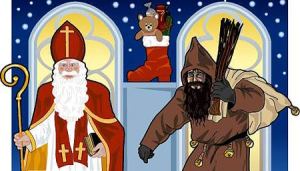
by Týra Alrune Sahsnotasvriunt
The Northern German Knecht Ruprecht (Slave Ruprecht/Farmhand Ruprecht) also referred to as Bur Klaas or Bullerklas is “Santa’s little helper”, a grim assistant clad in a brown who isn’t shy about using his rod on naughty children. He is referred to as a “tamed devil”, utterly obedient to “Wiehnachtsmann” though not by personal choice.
The name Ruprecht possibly derives from the word “Hruodperaht” meaning “glouriously shining one” – a byname of Wotan. This might be another way of Christians having attempted to assert their dominance over the Pagan population by stealing one of their Gods and turning him into a Christian slave.
However, many scholars also believe the name comes from the word “Ruhperht”, “rough Perchte”. Perchta or Berchta herself is Frija-Holle, her companions are the Perchten, both male and female figures who remind a lot of the Southern Krampus.

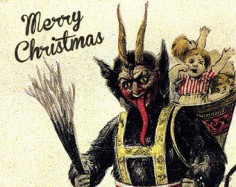
Krampus in turn is just another Alpine figure who – on Saint Nicholas’ order – punishes bad children with the rod. On the contrary to Knecht Ruprecht he looks like a sterotypical “devil” complete with horns and cloven hoofs a big crooked nose.
In the North Ruprecht was often depicted from the side and some say this is indeed a hint at the “one-eyed God”, Wotan;
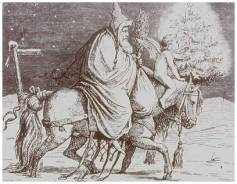
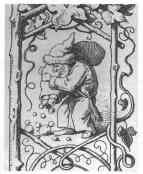
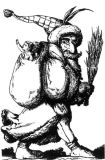 and taking into consideration the hooded cloak and hat, the rod that often looked like a (walking) staff or spear one can easily make this connection.
and taking into consideration the hooded cloak and hat, the rod that often looked like a (walking) staff or spear one can easily make this connection.
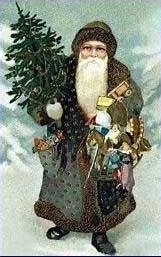
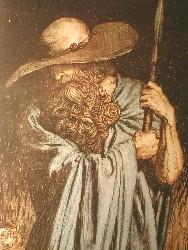
10 Oct 2015
by Týra Alrune Sahsnotasvriunt
in Folklore + Fairy Tales + Fables, Quick Facts
Tags: creatures, German mythology

by Týra Alrune Sahsnotasvriunt
The Stüpp is a kind of werewolf from the Rhineland area. He lies in wait for his victims at a crossroads, near a river, lake or at a cemetery and preferably attacks around midnight, jumping his victims’ backs, digging his claws deeply into them, so they can’t shake him off. (In Rhinish dialect this procedure is called “pöözen” or “hackeln”).
Once attached to his victim the parasitic Stüpp grows heavier and larger with each step the victim takes and also grows in size the more fear his victim feels, until he or she will go mad before dying from physical and mental overexhaustion and panic.
The Stüpp appears to be more of a blend between a werewolf and aptrgangr; he does not physically but mentally “deflesh” his victims and lies in wait for them in places traditionally inhabited by aptrgangr.
A tale from the Eifel confirms this: It tells of a man who committed suicide and who returned in the shape of a giant wolf who began tormenting those who he felt had wronged them when he was still alive/human.
Traditionally one could only limitedly fight a Stüpp. Some folk tales speak of people having fought off a Stüpp successfully by ramming an iron knife into his paw or snout while others say that if you knew the Stüpp’s once human name and called it out loud he would immediately let go and vanish completely.
24 Jan 2015
by Týra Alrune Sahsnotasvriunt
in Folklore + Fairy Tales + Fables, Quick Facts, Wights
Tags: goblin, Klabauter, Klabautermann, Klabautermänner, Kobold, water goblin, wight

by Týra Alrune Sahsnotasvriunt
A Klabautermann (from low German “klabastern” – “to rumble”) is a kind of water or ship goblin who assists sailors and fishermen on the North and Baltic Sea and saves sailors washed aboard.
He is approximately one foot (30cm) tall, dressed in sea-green or blue and a red woollen sailor’s cap, often wearing a caulking hammer and/or a pipe.
Klabautermänner are joyful and eager creatures with an expert understanding of all watercrafts, they live to serve, but also like to play pranks on those they serve and bless with their protection.
They also are quite skilled musicians and singers and as long as you hear your Klabautermann singing onboard, even during a heavy storm, you know your ship is safe.
Sailors better hope never to set eyes on the Klabauter though; he only shows himself to sailors and crews doomed to die.
23 Apr 2014
by Týra Alrune Sahsnotasvriunt
in Huli Spirituality, Quick Facts, Vaettir (Wights) + Spirits + Angels + Beings
Tags: Dama Dagenda, Huli mythology
Written by and copyrighted by Týra Alrune Sahsnotasvriunt, 2014

The Huli people of Papua New Guinea knew a terrifying creature named Dama Dagenda. They fiercely strike back against mankind inhabiting and conquering their jungle territories. Their hatred towards manking is mainly founded in the fact that they view humans as utterly destructive and a virus to the Earth. There is no bargaining with these spirits who mainly reside in or on trees and they will lash out at child, woman and man setting only one toe into their “realm”, punishing them with great pain, loss or even death. They speak all the languages of the tribes in the region and the only way to avoid their persecution is to seek out a medicine man/shaman and learn an ancient or new dialect from him; when transversing the jungle the Huli sang or loudly spoke this unknown dialect in order not to be harmed. Some Huli adopted the practice of singing or shouting complete nonsense, so that the Dama Dagenda wouldn’t recognize them as humans and hence leave them be.
23 Apr 2014
by Týra Alrune Sahsnotasvriunt
in Gods & Goddesses, Quick Facts
Tags: creation myth, Gilbert Islands, Nareau, Nareau te Moa-ni-bai, Oceanic mythology, Spider Lord
Written and copyrighted by Týra Alrune Sahsnotasvriunt

Nareau the Creator – whose name means “Spider Lord” – is an Oceanic high god of the Gilbert Islands. Before time was, Nareau’s full name was Nareau te Moa-ni-bai, Weaver Lord of the First Things. The legend is that in the beginning there was only Nareau who walked Te Bo ma Te Maki (the darkness and cleaving) in solitude. The creation myth is unclear, some say that Nareau wove the first two beings. Some say that when the darkness and cleaving started merging and producing substance, Nareau made Na Aribu and Nei Teukez out of sand and water. They in turn created the other Gods, amongst them the Ocotpus Lord, The Eel, The Wave, The Woman Between (the worlds – basically the first “witch”) and last was Nareau the Younger, the mischief maker. (Similarly to Heathens debating the role and character of Loki there are those that vehemently reject the idea that Nareau the Younger was a mischief maker, but that he was a deliverer.)
Nareau the Elder considered his work in terms of creating Gods was done and appointed the task of creating a world of and for man to Nareau the Younger. So that man would not be alone and separate from him, Nareau the Elder told his son to slay him and create the Earth out of his body. His right eye became the sun, the left eye the moon. His brain was scattered across the sky and became the stars. The Octopus Lord Na Kika helped form islands out of his flesh and make trees from his bones.
Nareau the Younger gave the children of the earth wit, spirit, conscience. Like his father, he was a weaver and thus he wove each man’s fate, tempting, testing and constantly putting obstacles in their ways, but with the intention that the children of the earth might disentangle themselves from his web and become their own masters, their own Gods.
08 Apr 2014
by Týra Alrune Sahsnotasvriunt
in Germanic and Norse Paganism and Heathenry, Gods & Goddesses, Indo-European Religions, Quick Facts
Tags: Gods, Heathenry, indo-Aryan religions, indo-European religions, Norse mythology, Norse Pagan, Norse Paganism, Scandinavian folk tales
Copyrighted and written by Penny Rebel

Kári [Kah-ree] is the Norse God of winter, frost, snow and the Northwind – or rather – he IS the Northwind itself. Like hardly any other God Kári represents the harshness of the Northern climate and overall life in Scandinavia and Germany. Fathered by the frostgiant Fornjotr he is brother to Loki (fire) and Aegir (water). On 18th century German paintings he is sometimes depicted as a youth in a spring setting and as an old man in winter settings; an indication that he changes and ages with the seasons.
The only mention of Kári in the Eddas is in one of Snorri’s thulur (rhymes) but traces of him can also be found in the Finnish Hversu (as the ruler of Finland) and Orkneyinga Saga. It is unclear whether Kári is father of one son named Frosti (frost) according to the Orkneyinga Saga or whether his name is Jökull according to the Hversu or whether these are two different sons. By Frost’s son Snaer, however, he is great-grandfather to Fon (snowfall), Drifa (snowdrift), and Mjöl (powder).
Although he is often accompanied by reindeer or depicted as riding a reindeer, being a God of the air and sky he is also associated with Northern birds such as the snow goose, snow owl, robin and it is also from thence that he started being regarded as the ‘patron’ of singers, bards and those who otherwise use their voice artistically or professionally. In spring Kari’s own voice is the gentle breeze caressing the first buds and leaves, but in winter his song is more of an eerie howl or screech as he haunts the North with blizzards and snowstorms, bemoaning his own age and approaching “death”. Alas, he will be born again in the ever-repeating cycle of the seasons.
08 Apr 2014
by Týra Alrune Sahsnotasvriunt
in Gods & Goddesses, Hinduism, Indo-European Religions, Quick Facts
Tags: Buddhism, Dark Mother, Dark Mother Figure, Goddess, Goddesses, Hinduism, indo-Aryan religions, indo-European religions
Copyrighted and written by Týra Alrune Sahsnotasvriunt, 2014

Chinnamasta, a Hindu Goddess with origins in Nepal and Northern India also acknowledged by Buddhists, is a Goddess of (sexual) abstinence and self-sacrifice. Emphasizing the latter of her main traits, she cut off her own head and thus her name literally means “She whose head is severed”. Depictions of her usually involve her standing on a copulating couple with blood spouting from her decapitated neck. In offering her own head/third eye and crown chakra to the world she represents the triumph of willpower and spirit over flesh. Unsurprisingly, she has few followers and is known as a ferocious and merciless Goddess to those that stray from her path of enlightenment. Her worshippers mainly include yogis, certain kinds of Tantric practitioners and askets or other world renouncers.
Although Chinnamasta is a Goddess, she both possesses as well as grants “demonic” powers to her worshippers. These include control of one’s foes by “poetic speech”, removal of obstacles, ability to sway kings or authority figures in genereal, conquest over the “weak-willed” and finally, salvation.
08 Apr 2014
by Týra Alrune Sahsnotasvriunt
in Quick Facts, Shintoism
Tags: Goddess, Goddesses, Shinto, Shintoism
Copyrighted and written by Týra Alrune Sahsnotasvriunt, 2014
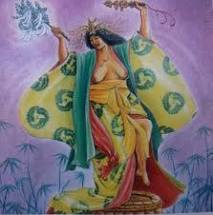
Ame-no-Uzume-no-mikoto or simply Uzume is the Shinto Goddess of myrth, revelry, dawn and dance. She is also praised as “the Heavens’ forthright female”. As a reference to her capacity as a Goddess of dance Uzume translates to “whirling”. A name suiting her well, since she is also associated with life-giving streams and waters. Lore has it that when Susano, God of storm, vandalized the Sun-deity Amaterasu’s rice fields, she withdrew into a cave and refused to come out until he had apologized. The world was thrown into darkness and despair. The Gods could not convince her to return to earth, but clever Uzume turned over a large tub near the cave entrance and began a whirling, joyful dance atop it. When the sound of feet on the tub was not enough to lure Amaterasu out of her hiding place, Uzume began tearing off her clothes, prompting the crowd to cheer and laugh. Curious now, Amaterasu carefully peered out of the cavern entrance and found herself face to face with her own reflection in a mirror placed at the cavern entrance by Uzume. Thus Uzume convinced Amaterasu to return into the sky instead of hiding her beauty and light away.
As a reward for restoring the world to balance, her brother Ninigi married Uzume to the God who guards the Floating Bridge to Heaven.
The dances of Uzume are still found in today’s folk rite of waking the dead, the one of planting seeds and the Kagura, traditional dance-mime.
08 Apr 2014
by Týra Alrune Sahsnotasvriunt
in African Paganism, Gods & Goddesses, Quick Facts
Tags: African Goddess, African Goddesses, African Paganism, Goddess, Pagan Goddesses, Yoruba
Copyrighted and written by Týra Alrune Sahsnotasvriunt, 2014

Yemaya is The Great Mother in the Ífa’s and Yoruba’s beliefs and rules over the seas. Just like in many other traditions water is the symbol of life itself. Yemaya is maternal and nurturing, though not in the traditional sense. She nurtures her children much like Angrboda, Wenet or Lilitu by testing their willpower, strength and determination. She is not a meek Mother Goddess figure but represents the hardships of life (birth, rebirth, childbirth as well as death and demise). Her punishments can be terrible, but she’s fair minded and forgiving when remorese is shown and amends are being made. Yemaya is a wise yet cunning Goddess and she is praised for her bravery and unselfishness by her followers. When she goes to war on behalf of her children (followers), she wields a machete and no one can defeat her. She’s often depicted as wearing long flowing blue-white dresses, representing the waves of the ocean – the “waves” (ups and downs) of life.
 However there were those kids of Lares who were guardians of a specific city, village or sacred site, the Lares Loci and Lares Publici. Shrines built to honor the Lares Publici were often erected at crossroads or near cemeteries.
However there were those kids of Lares who were guardians of a specific city, village or sacred site, the Lares Loci and Lares Publici. Shrines built to honor the Lares Publici were often erected at crossroads or near cemeteries.


















